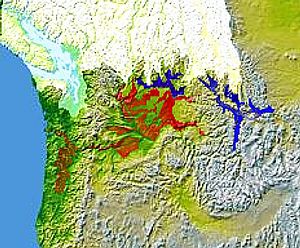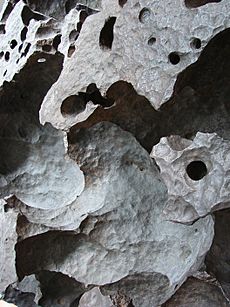Willamette Meteorite facts for kids
Quick facts for kids Willamette |
|
|---|---|

Willamette Meteorite at the American Museum of Natural History
|
|
| Type | Iron |
| Structural classification | Medium Octahedrite |
| Group | IIIAB |
| Composition | 91% Fe, 7.62% Ni, 18.6ppm Ga, 37.3ppm Ge, 4.7ppm Ir |
| Country | United States |
| Region | Oregon |
| Coordinates | 45°22′N 122°35′W / 45.367°N 122.583°W |
| Observed fall | No |
| Found date | Unknown |
| TKW | 14,150 kilograms (15.60 short tons) |
| [[Commons:Category:Lua error in Module:Wikidata at line 70: attempt to index field 'wikibase' (a nil value). |Related media on Wikimedia Commons]] | |
The Willamette Meteorite is a huge space rock found in Oregon, United States. Its official name is Willamette. The Clackamas Chinook Native American tribe originally called it Tomanowos.
This meteorite is made mostly of iron and nickel. It is the biggest meteorite ever found in North America. It is also the sixth largest meteorite found anywhere in the world!
When it was found, there was no impact crater nearby. Scientists believe it landed far away, maybe in Canada or Montana. It was then carried by huge floods during the last Ice Age, about 13,000 years ago. These floods moved giant ice blocks, and the meteorite was likely stuck inside one.
Native American tribes in the Willamette Valley have long seen this meteorite as a sacred object. Today, the meteorite is on display at the American Museum of Natural History in New York City. It has been there since 1906. Millions of people have seen it, making it one of the most famous meteorites.
In 2005, the Confederated Tribes of the Grand Ronde Community of Oregon (CTGRC) wanted the meteorite back. They reached an agreement with the museum. The tribe can visit the meteorite for ceremonies. The museum can keep it as long as it is on display.
Contents
What is the Willamette Meteorite Made Of?
The Willamette Meteorite weighs about 34,200 pounds (15,500 kg). That's like the weight of two large elephants! It is about 10 feet (3 m) tall, 6.5 feet (2 m) wide, and 4.25 feet (1.3 m) deep.
It is mostly made of iron (over 91%) and nickel (7.62%). It also has tiny amounts of other elements like cobalt and phosphorus.
Most iron meteorites, like Willamette, come from the center of small planets or asteroids. These objects crashed into other space rocks long ago. The Willamette Meteorite shows signs of a big impact event. This means it was heated up a lot when its parent body crashed.
It also contains rare metals, like iridium. Iridium is very uncommon on Earth.
How Did the Meteorite Get Here?

For a long time, people wondered why there was no impact crater where the meteorite was found. This mystery was solved after the 1920s. Scientists learned about the Missoula Floods. These were some of the biggest floods ever known. They happened when a huge ice dam broke during the last Ice Age.
Scientists believe the meteorite landed on an ice sheet. This was likely in what is now Montana or western Canada. The ice sheet slowly carried the meteorite towards an ice dam. This dam was holding back a giant lake called Lake Missoula.
When the ice dam broke, a massive amount of water rushed out. Huge blocks of ice floated down the Columbia River and into the Willamette Valley. Some of these ice blocks carried large rocks, like the Willamette Meteorite. Geologists call these rocks "glacial erratics." When the ice melted, the meteorite settled where it was found. This happened about 13,000 years ago.
The deep holes and grooves on the meteorite formed in two ways. First, they were created when it entered Earth's atmosphere at high speed. Second, they formed over thousands of years from weathering. Rainwater mixed with a mineral called troilite inside the meteorite. This created a weak sulfuric acid. The acid slowly dissolved parts of the meteorite, making the hollows we see today.
The Meteorite's Journey Through History
The Clackamas people have honored the Willamette Meteorite, which they call Tomanowos, for a very long time. It was in the Willamette Valley, near what is now West Linn, Oregon.
In 1902, a settler named Ellis Hughes found the meteorite. The land belonged to the Oregon Iron and Steel Company. Hughes tried to claim the meteorite as his own. He secretly moved it to his land. This took him 90 days of hard work. The company found out, and a court decided the company owned the meteorite.
In 1905, Mrs. William E. Dodge Jr. bought the meteorite for $26,000. This would be worth about $680,000 today. She showed it at an exhibition. Then, she gave it to the American Museum of Natural History in New York City. It has been on display there since 1906.
The Confederated Tribes of the Grand Ronde Community of Oregon (CTGRC) use the meteorite in their ceremonies. In 1999, they asked for the meteorite to be returned. After discussions, an agreement was made in 2000. The meteorite would stay at the museum. Tribe members could hold a private ceremony around it once a year. If the museum ever stops displaying it, ownership will go to the CTGRC.
In 2007, a politician from Oregon tried to pass a resolution. It would have asked the museum to return the meteorite to Oregon. However, the tribes said they were happy with the agreement. They did not support the resolution.
A smaller piece of the meteorite, weighing 28-pound (13 kg), was traded in 1997. It was planned for auction in 2007. This caused some concern. However, the tribes stated they would not sue a new owner. The piece was later withdrawn from the auction. Another 4.5-ounce (130 g) piece was bought in 2006. It was displayed in a museum in Oregon. This piece was returned to the Confederated Tribes of the Grande Ronde in 2019.
How Much Does It Weigh?

There has been some confusion about the exact weight of the Willamette Meteorite. This is because different types of "tons" are used. Some sources say it weighs 15,500 kilograms (34,200 lb), while others say 12,700 kilograms (28,000 lb).
The American Museum of Natural History's website has also listed different weights. In 1906, they said it was "at least 31,200 pounds, or about 15.6 tons." Today, most agree the meteorite weighs about 14,150 kilograms (31,200 lb).
Where Can You See Replicas?
You can find copies of the Willamette Meteorite in a few places:
- A replica is in Eugene, Oregon. It is outside the University of Oregon Museum of Natural and Cultural History.
- Another replica stands near the Willamette Methodist Church in West Linn, Oregon.
- The only exact copy is at the Chachalu Museum. This museum belongs to the Confederated Tribes of Grand Ronde (CTGR) in Grand Ronde, Oregon. This replica was made from aluminum using a special 3D scanning process.
Images for kids
See also
 In Spanish: Meteorito Willamette para niños
In Spanish: Meteorito Willamette para niños



